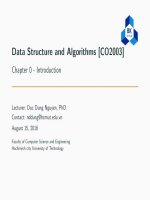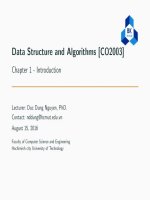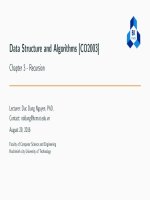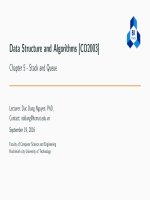C++ programming program design including data structure 7th ch11
Bạn đang xem bản rút gọn của tài liệu. Xem và tải ngay bản đầy đủ của tài liệu tại đây (512.39 KB, 38 trang )
Chapter 11:
Inheritance and Composition
Objectives
• In this chapter, you will:
– Learn about inheritance
– Learn about derived and base classes
– Explore how to redefine the member functions of a base
class
– Examine how the constructors of base and derived classes
work
– Learn how the destructors of base and derived classes
work
C++ Programming: Program Design Including Data Structures, Seventh Edition
2
Objectives (cont’d.)
– Learn how to construct the header file of a derived class
– Become aware of stream classes hierarchy
– Explore three types of inheritance: public,
protected, and private
– Learn about composition (aggregation)
– Become familiar with the three basic principles of objectoriented design
C++ Programming: Program Design Including Data Structures, Seventh Edition
3
Introduction
• Two common ways to relate two classes in a
meaningful way are:
– Inheritance (“is-a” relationship)
– Composition, or aggregation: (“has-a” relationship)
C++ Programming: Program Design Including Data Structures, Seventh Edition
4
Inheritance
• Inheritance: “is-a” relationship
– Example: “every employee is a person”
• Inheritance allows creation of new classes from
existing classes
– Derived classes: new classes created from the existing class
– Base class: the original class
• Derived class inherits the properties of its base
classes
C++ Programming: Program Design Including Data Structures, Seventh Edition
5
Inheritance (cont’d.)
• Inheritance helps reduce software complexity
• Single inheritance: derived class has a single base
class
• Multiple inheritance: derived class has more than
one base class
• Public inheritance: all public members of base class
are inherited as public members by derived class
C++ Programming: Program Design Including Data Structures, Seventh Edition
6
Inheritance (cont’d.)
• Inheritance can be viewed as a tree-like, or
hierarchical, structure between the base class and its
derived classes
C++ Programming: Program Design Including Data Structures, Seventh Edition
7
Inheritance (cont’d.)
• Syntax of a derived class:
– memberAccessSpecifier is public, protected,
or private (default)
• private members of a base class are private to
the base class
– Derived class cannot directly access them
C++ Programming: Program Design Including Data Structures, Seventh Edition
8
Inheritance (cont’d.)
• public members of base class can be inherited as
public or private members
• Derived class can include additional members (data
and/or functions)
• Derived class can redefine public member
functions of the base class
– Applies only to the objects of the derived class
• All member variables of the base class are also
member variables of the derived class
C++ Programming: Program Design Including Data Structures, Seventh Edition
9
Redefining (Overriding) Member
Functions of the Base Class
• To redefine a public member function:
– Corresponding function in derived class must have same
name/number/types of parameters
• If derived class overrides a public member
function of the base class, then to call the base class
function, specify:
– Name of the base class
– Scope resolution operator (::)
– Function name with appropriate parameter list
C++ Programming: Program Design Including Data Structures, Seventh Edition
10
Redefining Member Functions of the
Base Class (cont’d.)
C++ Programming: Program Design Including Data Structures, Seventh Edition
11
Redefining Member Functions of the
Base Class (cont’d.)
• boxType is derived from rectangleType, and it
is a public inheritance
– Also overrides print and area
C++ Programming: Program Design Including Data Structures, Seventh Edition
12
Constructors of Derived and Base
Classes
• Derived class constructor cannot directly access
private members of the base class
– It can directly initialize only public member variables of
the base class
• When a derived object is declared, it must execute
one of the base class constructors
• Call to base class constructor is specified in heading
of derived class constructor definition
C++ Programming: Program Design Including Data Structures, Seventh Edition
13
Destructors in a Derived Class
• Destructors: used to deallocate dynamic memory
allocated by the objects of a class
• When a derived class object goes out of scope
– Automatically invokes its destructor
• When the destructor of the derived class executes
– Automatically invokes the destructor of the base class
C++ Programming: Program Design Including Data Structures, Seventh Edition
14
Header File of a Derived Class
• To define new classes, create new header files
• To create new derived classes, include commands
that specify where the base class definitions can be
found
• Definitions of the member functions can be placed in
a separate file
C++ Programming: Program Design Including Data Structures, Seventh Edition
15
Multiple Inclusions of a Header File
• Use the preprocessor command (#include) to
include a header file in a program
– Preprocessor processes the program before it is compiled
• To avoid multiple inclusion of a file in a program, use
certain preprocessor commands in the header file
C++ Programming: Program Design Including Data Structures, Seventh Edition
16
C++ Stream Classes
• ios is the base class for all stream classes
– Contains formatting flags and member functions to
access/modify the flag settings
C++ Programming: Program Design Including Data Structures, Seventh Edition
17
C++ Stream Classes (cont’d.)
• istream and ostream provide operations for
data transfer between memory and devices
– istream defines the extraction operator (>>) and
functions get and ignore
– ostream defines the insertion operator (<<) which is
used by cout
• ifstream/ofstream objects are for file I/O
– Header file fstream contains the definitions for these
C++ Programming: Program Design Including Data Structures, Seventh Edition
18
Protected Members of a Class
• Derived class cannot directly access private
members of it base class
• To give it direct access, declare that member as
protected
C++ Programming: Program Design Including Data Structures, Seventh Edition
19
Inheritance as public, protected,
or private
• Assume class B is derived from class A with
• If memberAccessSpecifier is public:
–public members of A are public in B, and can be
directly accessed in class B
–protected members of A are protected in B, and can
be directly accessed by member functions (and friend
functions) of B
–private members of A are hidden in B and can be
accessed only by public or protected members of A
C++ Programming: Program Design Including Data Structures, Seventh Edition
20
Inheritance as public, protected,
or private (cont’d.)
• If memberAccessSpecifier is protected:
– public members of A are protected members of B
and can be accessed by the member functions (and friend
functions) of B
– protected members of A are protected members of
B and can be accessed by the member functions (and
friend functions) of B
– private members of A are hidden in B and can be
accessed only through public or protected members
of A
C++ Programming: Program Design Including Data Structures, Seventh Edition
21
Inheritance as public, protected, or
private (cont’d.)
• If memberAccessSpecifier is private:
– public members of A are private members of B and
can be accessed by member functions of B
– protected members of A are private members of B
and can be accessed by member functions (and friend
functions) of B
– private members of A are hidden in B and can be
accessed only through public/protected members of
A
C++ Programming: Program Design Including Data Structures, Seventh Edition
22
Composition (Aggregation)
• In composition, one or more member(s) of a class
are objects of another class type
• Composition (aggregation): “has-a” relation
• Arguments to the constructor of a member-object
are specified in the heading part of the definition of
the constructor
C++ Programming: Program Design Including Data Structures, Seventh Edition
23
Composition (Aggregation) (cont’d.)
• Member-objects of a class are constructed in the
order they are declared
– Not in the order listed in the constructor’s member
initialization list
• They are constructed before the containing class
objects are constructed
C++ Programming: Program Design Including Data Structures, Seventh Edition
24
Object-Oriented Design (OOD) and ObjectOriented Programming (OOP)
• The fundamental principles of object-oriented design
(OOD) are:
– Encapsulation: combines data and operations on data in a
single unit
– Inheritance: creates new objects (classes) from existing
objects (classes)
– Polymorphism: the ability to use the same expression to
denote different operations
C++ Programming: Program Design Including Data Structures, Seventh Edition
25









